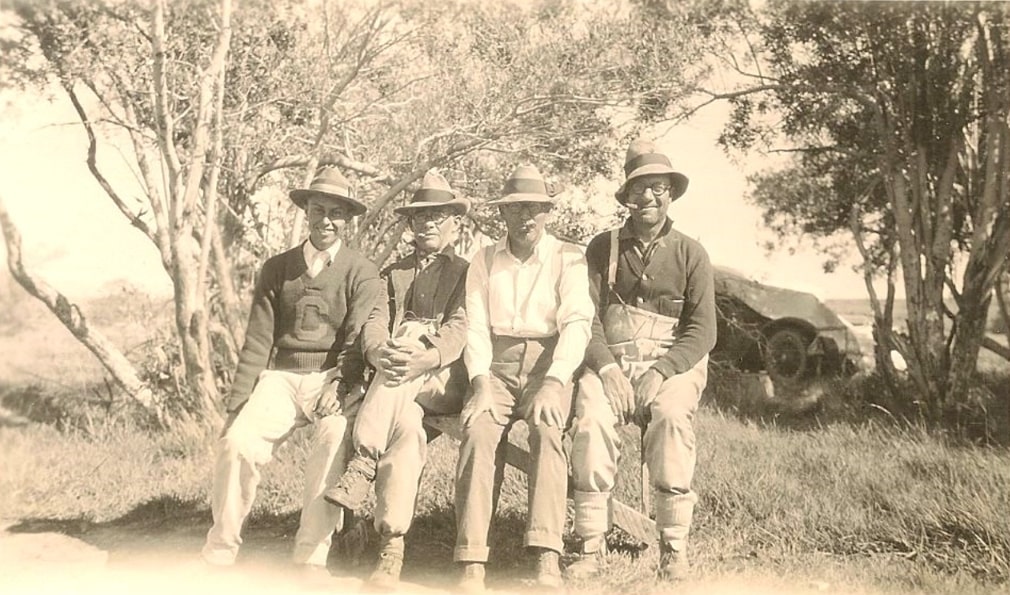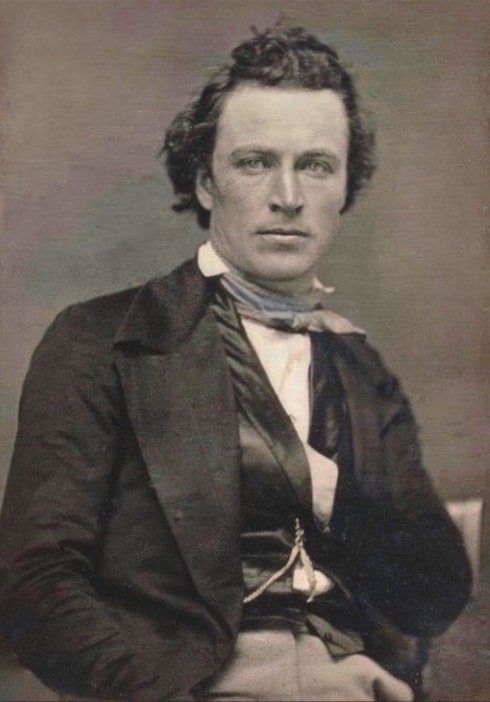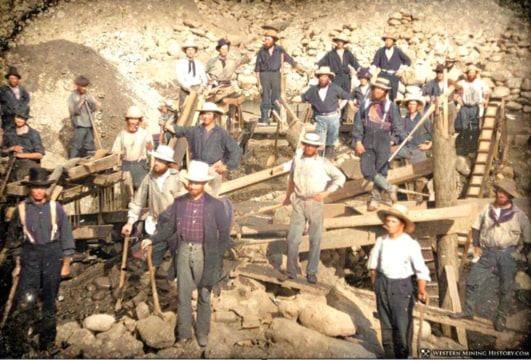Introduction: In this article, Melissa Davenport Berry tells more stories about the California Gold Rush, based on letters a “49er” gold prospector wrote. Melissa is a genealogist who has a blog, AnceStory Archives, and a Facebook group, New England Family Genealogy and History.
Today I continue with my series “Letters from California Gold Rush ‘49er.’” William Luckow, a client, shared a large collection of letters written by his ancestor Francis Henry Nicholson (1829-1884), who was among the many Americans who got the “gold rush fever” and headed out to California to make his fortune in 1849.
Most of Francis’ letters were written from Nevada City, California, to his sweetheart Elizabeth “Lizzie” Charles, whom he later married. They had eight children. Here is a photo from the family album.

In this photo, (from left to right):
- Samuel Henry Luitwieler, son of George Chichester Luitwieler and Mary Estelle Dillingham, who married Mary Elizabeth Nicholson, daughter of Clara Savage and George Henry Nicholson, and granddaughter of Francis Henry Nicholson and Elizabeth “Lizzie” Charles.
- George Henry Nicholson, son of Francis Henry Nicholson and Elizabeth “Lizzie” Charles, who married Clara Savage, daughter of California State Senator William Henry Savage and his wife Mary Agnes White.
- Joseph Walter Nicholson, son of Francis Henry Nicholson and Elizabeth “Lizzie” Charles, who married Clara Isabel Harms.
- Edmund Aloysius Nicholson, son of Francis Henry Nicholson and Elizabeth “Lizzie” Charles, who married Edith L. Quinn.
A letter from 1858 from Francis to Lizzie recalled his visit to the theater to see a play performed by famous pioneer stage actor James Stark (1819-1875).

Here is a photo of that 1858 letter from Francis to Lizzie.
Here is a transcription of the section describing Francis’ theater visit:
While I was in San Francisco I heard Mr. Stark play “Richelieu” by Bulwer. It pleased me very much – one passage in particular. Richelieu is a cardinal and has a ward to whom he is much attached, a daughter of an old friend of his who left her in the Cardinal’s care when he died. She has a lover and secretly marries him, the Cardinal officiating. The King orders her to marry another, which she is loth to do – and the Cardinal using his power to prevent it, enrages the King, who sends the “hombre” with forces to take her away and to unite her to his favorite by force. But the Cardinal as a last resort draws an imaginary circle around her, and will launch the Curse of Rome upon him who comes within the circle – which they all, of course, dare not risk and she is saved. I felt my heart warm and really felt thankful to that power thus portrayed in the protection of innocence.
I found an advertisement in the Daily National Democrat for the play which Francis referenced in his letter, at the Marysville Theater – Richelieu, or The Conspiracy – a role which made James Stark extremely popular in his career.
James portrayed the lead role of Cardinal Richelieu and his wife Sarah Kirby Stark (1813-1898) was Julie de Mortimer, an orphan the cardinal adopted.
In that same 1858 letter Francis wrote:
Thos. P. Hawley was married this week and is absent on a wedding tour.
I found the matrimony notice in the New York Herald.
This wedding notice read:
HAWLEY-MURRELL. – At Nevada, Nov. 15, [1858], Thos. P. Hawley to Eudora Murrell.
Hon. Judge Thomas Porter Hawley (1803-1908), son of Ebenezer Sanford Hawley and Eliza Porter Stevenson, married Miss Eudora Murrell, daughter of John Thomas Murrell and Sarah Frances Bobo, and left descendants.
Hawley engaged in mining and was county clerk. He had a private law practice and eventually was elected Nevada County District Attorney, and later appointed a federal judge.
Francis Henry Nicholson served as a public administrator in Nevada and knew Hawley both personally and professionally.
In another letter dated 12 March 1858, Francis wrote:
Hank Kinney is at Humbug City working diggings that he & Bill Pickle bought recently.
Humbug, now North Bloomfield, got its name for the same reason Poverty Hill and Jackass Creek got theirs – named by prospectors who did not find their fortunes. Thus, this creek was a “humbug.”
However, a few miners stayed and called the new mining camp “Humbug City.”
In November of 1858 the San Francisco Bulletin published an account of Humbug City:
Why this place received the above name, I do not know; but judging from its deserted appearance, the inference is reasonable that many have been humbugged.
The article reported that nearly 200 houses had been built, but many were now unoccupied. There was hardly any drinking or gambling due to the lack of men. A theater was present and a church, but with no standing preacher.
The main issue was “the want of water to work the mines,” but that was about to change.
Stay tuned…
Explore over 330 years of newspapers and historical records in GenealogyBank. Discover your family story! Start a 7-Day Free Trial
Note on the header image: 1852 image of 23 miners at a California placer operation (colorized). Credit: Western Mining History.
Related Articles:
